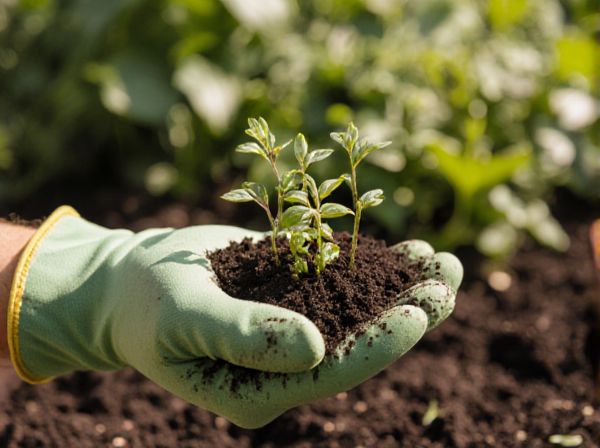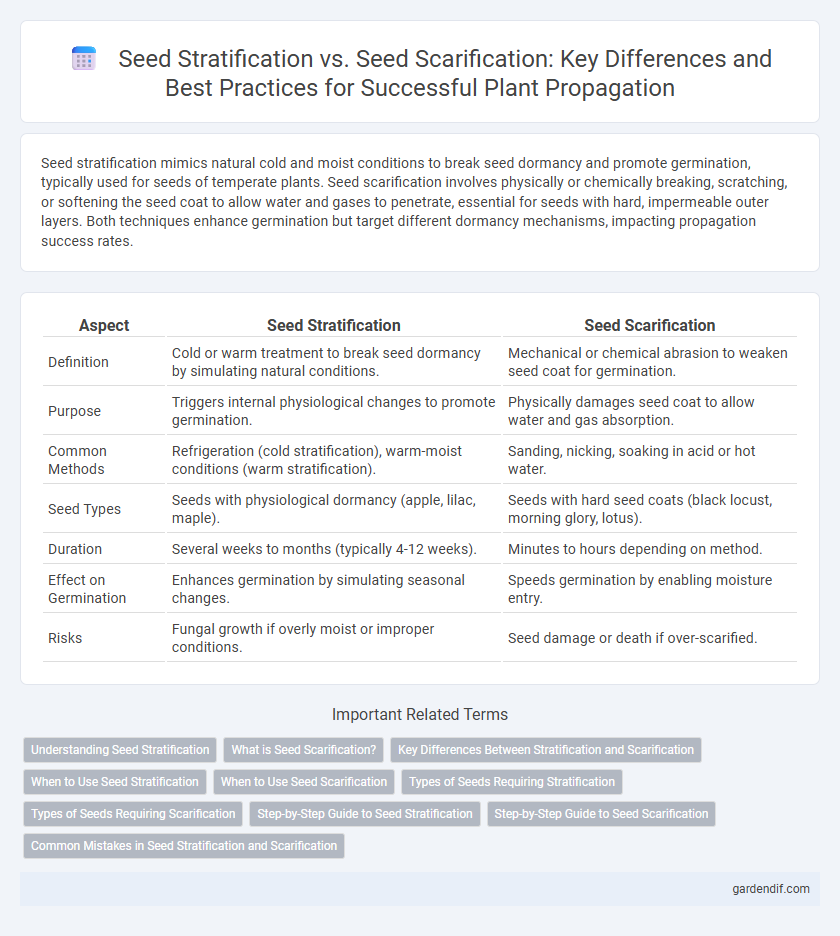
Seed Stratification vs Seed Scarification Illustration
Seed stratification mimics natural cold and moist conditions to break seed dormancy and promote germination, typically used for seeds of temperate plants. Seed scarification involves physically or chemically breaking, scratching, or softening the seed coat to allow water and gases to penetrate, essential for seeds with hard, impermeable outer layers. Both techniques enhance germination but target different dormancy mechanisms, impacting propagation success rates.
Table of Comparison
| Aspect | Seed Stratification | Seed Scarification |
|---|---|---|
| Definition | Cold or warm treatment to break seed dormancy by simulating natural conditions. | Mechanical or chemical abrasion to weaken seed coat for germination. |
| Purpose | Triggers internal physiological changes to promote germination. | Physically damages seed coat to allow water and gas absorption. |
| Common Methods | Refrigeration (cold stratification), warm-moist conditions (warm stratification). | Sanding, nicking, soaking in acid or hot water. |
| Seed Types | Seeds with physiological dormancy (apple, lilac, maple). | Seeds with hard seed coats (black locust, morning glory, lotus). |
| Duration | Several weeks to months (typically 4-12 weeks). | Minutes to hours depending on method. |
| Effect on Germination | Enhances germination by simulating seasonal changes. | Speeds germination by enabling moisture entry. |
| Risks | Fungal growth if overly moist or improper conditions. | Seed damage or death if over-scarified. |
Understanding Seed Stratification
Seed stratification mimics natural winter conditions by exposing seeds to prolonged cold and moist environments, breaking their dormancy to promote uniform germination. This process is essential for species such as apples, cherries, and many perennials that require chilling periods to trigger metabolic changes in the embryo. Understanding stratification enables gardeners to optimize propagation timing and improve seedling vigor for cold-climate plants.
What is Seed Scarification?
Seed scarification is a propagation technique that involves physically breaking, scratching, or softening the seed coat to enhance water absorption and promote germination. This method accelerates the germination process for seeds with hard or impermeable seed coats, such as legumes or certain tree species. Mechanical, chemical, or thermal treatments are commonly used to achieve effective scarification, improving seed viability and growth potential.
Key Differences Between Stratification and Scarification
Seed stratification mimics natural winter conditions by exposing seeds to cold, moist environments, breaking dormancy through temperature cues that stimulate germination. In contrast, seed scarification involves physically or chemically altering the seed coat to enhance water absorption and gas exchange, overcoming physical dormancy barriers. Stratification targets physiological dormancy, while scarification addresses mechanical dormancy, making these methods essential for different seed types in propagation.
When to Use Seed Stratification
Seed stratification is essential for breaking seed dormancy in plant species requiring a period of cold, moist conditions to initiate germination, such as apples, cherries, and many temperate perennials. This process is most effective when applied during the natural winter months or simulated indoors to mimic seasonal changes. Use seed stratification for species with hard seed coats or physiological dormancy that prevents immediate sprouting without exposure to cold temperatures.
When to Use Seed Scarification
Seed scarification is essential when germinating seeds with hard, impermeable seed coats, such as those of morning glories, sweet peas, and certain tree species like redbud and black locust. This method physically breaks or weakens the seed coat to allow water and gases to penetrate, promoting faster and more uniform germination. Use seed scarification when seeds fail to germinate after standard soaking or when dealing with naturally dormant seeds that require mechanical intervention for successful propagation.
Types of Seeds Requiring Stratification
Most temperate tree species, including apple, cherry, and maple, require seed stratification to break dormancy by simulating natural winter conditions. Stratification is essential for seeds with physiological dormancy, such as those of many deciduous trees, lilies, and some wildflowers. In contrast, seeds that need scarification usually possess hard, impermeable seed coats typical of species like legumes and certain shrubs.
Types of Seeds Requiring Scarification
Certain hard-coated seeds such as those of legumes, morning glories, and species like redbud require scarification to break physical dormancy by weakening the tough seed coat. Scarification methods for these seeds include mechanical, thermal, or chemical treatments that allow water and gases to penetrate and initiate germination. Unlike seeds needing stratification, which require temperature and moisture cues, scarification targets seeds with impermeable seed coats that inhibit imbibition.
Step-by-Step Guide to Seed Stratification
Seed stratification involves exposing seeds to cold, moist conditions to break dormancy and enhance germination rates, typically requiring refrigeration at 1-5degC for 2 to 12 weeks depending on species. Begin by moistening a sterile substrate such as sand, peat moss, or paper towel, then mix the seeds thoroughly in the substrate and place them in a sealed plastic bag or container to maintain humidity. Monitor the seeds regularly, ensuring the substrate remains damp but not waterlogged, and move to germination conditions once the stratification period ends.
Step-by-Step Guide to Seed Scarification
Seed scarification involves physically altering the seed coat to enhance water absorption and germination rates, often through methods like mechanical abrasion, hot water treatment, or acid soaking. Begin by selecting a durable seed coat species, then gently sand or nick the seed surface with sandpaper or a knife to weaken the outer layer without damaging the embryo. After scarification, soak the seeds in water for 12 to 24 hours to further soften the seed coat and initiate the germination process.
Common Mistakes in Seed Stratification and Scarification
Common mistakes in seed stratification include incorrect temperature settings and insufficient moisture levels, which hinder proper dormancy breaking and germination rates. In seed scarification, over-sanding or excessive chemical exposure can damage the seed coat, reducing viability and leading to poor sprouting outcomes. Proper technique and monitoring of these factors are essential to optimize propagation success in both methods.
Seed Stratification vs Seed Scarification Infographic

 gardendif.com
gardendif.com